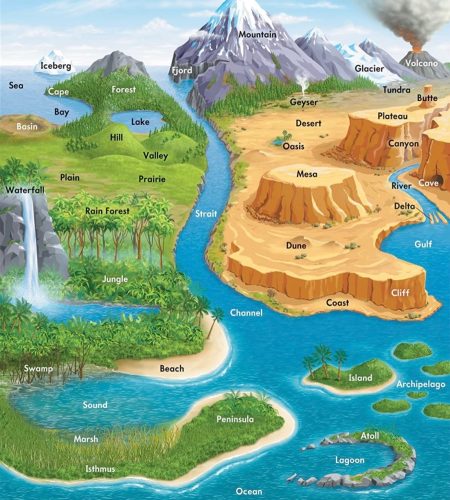
Geography is a vast field that encompasses the study of the Earth’s landscapes, environments, and the relationships between people and their environments. Here, we provide a comprehensive guide to the most important geography terms, complete with full definitions and examples.
1. Continent
Definition: A continent is a large continuous landmass that is distinct from others due to geographical and cultural factors. There are seven recognized continents: Africa, Antarctica, Asia, Europe, North America, Australia (Oceania), and South America.
Example: Asia is the largest continent, both in terms of area and population. It includes diverse countries such as China, India, and Japan.
2. Ocean
Definition: An ocean is a vast body of saltwater that covers approximately 71% of the Earth’s surface. There are five main oceans: the Pacific, Atlantic, Indian, Southern, and Arctic Oceans.
Example: The Pacific Ocean is the largest and deepest ocean, bordered by continents such as Asia and Australia.
3. Latitude
Definition: Latitude is the measurement of distance north or south of the Equator, expressed in degrees. The Equator is at 0° latitude, while the poles are at 90° north and south latitude.
Example: The city of Quito in Ecuador is located near the Equator, with a latitude of approximately 0°.
4. Longitude
Definition: Longitude is the measurement of distance east or west of the Prime Meridian, which is located at 0° longitude in Greenwich, England. Longitudes are expressed in degrees, up to 180° east or west.
Example: The city of London, UK, is situated at a longitude of about 0°, being near the Prime Meridian.
5. Hemisphere
Definition: A hemisphere is half of the Earth, divided by the Equator into Northern and Southern Hemispheres, or by the Prime Meridian into Eastern and Western Hemispheres.
Example: The United States is located in the Northern Hemisphere and the Western Hemisphere.
6. Archipelago
Definition: An archipelago is a group or chain of islands clustered together in a sea or ocean.
Example: The Philippines is an archipelago consisting of over 7,000 islands in Southeast Asia.
7. Peninsula
Definition: A peninsula is a piece of land that is surrounded by water on three sides but connected to the mainland.
Example: The Iberian Peninsula, which includes Spain and Portugal, is surrounded by the Mediterranean Sea and the Atlantic Ocean.
8. Delta
Definition: A delta is a landform created by the deposition of sediment at the mouth of a river where it flows into an ocean, sea, or lake.
Example: The Nile Delta in Egypt is a fertile region where the Nile River spreads out and drains into the Mediterranean Sea.
9. Mountain Range
Definition: A mountain range is a series of connected mountains that form a long, continuous elevated area.
Example: The Himalayas, home to Mount Everest, form a major mountain range in Asia, separating the plains of the Indian subcontinent from the Tibetan Plateau.
10. Plateau
Definition: A plateau is a flat, elevated landform that rises sharply above the surrounding area on at least one side.
Example: The Colorado Plateau in the United States is known for its high elevation and extensive area, covering parts of Utah, Colorado, Arizona, and New Mexico.
11. Basin
Definition: A basin is a large, bowl-shaped depression in the Earth’s surface, typically filled with water or sediment.
Example: The Amazon Basin in South America is drained by the Amazon River and its tributaries, forming one of the largest river basins in the world.
12. Desert
Definition: A desert is a barren area of landscape where little precipitation occurs, resulting in hostile living conditions for plants and animals.
Example: The Sahara Desert in North Africa is the largest hot desert in the world, known for its vast stretches of sand dunes.
13. Island
Definition: An island is a piece of land completely surrounded by water, smaller than a continent.
Example: Iceland is an island country in the North Atlantic, known for its volcanic landscapes and geysers.
14. Isthmus
Definition: An isthmus is a narrow strip of land connecting two larger land areas, typically with water on either side.
Example: The Isthmus of Panama connects North and South America and contains the Panama Canal.
15. Plain
Definition: A plain is a flat, broad area of land with minimal changes in elevation, often covered with grasses.
Example: The Great Plains in North America extend from Canada to Texas, known for their fertile soil and agricultural productivity.
16. Valley
Definition: A valley is a low area of land between hills or mountains, often with a river running through it.
Example: The Yosemite Valley in California is a famous glacial valley known for its stunning granite cliffs and waterfalls.
17. Fjord
Definition: A fjord is a long, narrow, deep inlet of the sea between high cliffs or steep slopes, created by glacial erosion.
Example: The fjords of Norway are renowned for their dramatic scenery, with steep cliffs rising from the water.
18. River
Definition: A river is a large, flowing body of water that moves from higher to lower land, usually emptying into a sea or ocean.
Example: The Amazon River in South America is the largest river by discharge volume of water in the world.
19. Volcano
Definition: A volcano is an opening in the Earth’s crust through which molten rock, ash, and gases are ejected during eruptions.
Example: Mount Vesuvius in Italy is a famous volcano known for its eruption in AD 79 that buried the cities of Pompeii and Herculaneum.
20. Glacier
Definition: A glacier is a large, slow-moving mass of ice formed from compacted snow in areas where snow accumulation exceeds melting.
Example: The Greenland Ice Sheet is a vast glacier that covers approximately 80% of Greenland’s surface.
Conclusion
Understanding these major geography terms provides a foundational knowledge of the Earth’s physical features and the processes that shape them. Each term represents a crucial aspect of the natural world, contributing to our comprehension of the planet’s diverse landscapes.
Disclaimer: The information presented in this article is based on the available data and current events around the time of publication, to the best of our staff research and knowledge. It is intended for educational and informational purposes only, and should not be construed as professional advice, financial advice, sports betting advice, or life advice. It is simply our best guess, something to add to your research. We at Las Vegas Top Picks do our best to get stories accurate, but sometimes mistakes and biases happen, and it is always good to double-check other sources and media outlets to confirm stories and the factual details. The opinions expressed in this article do not necessarily reflect the overall opinion of Las Vegas Top Picks.








